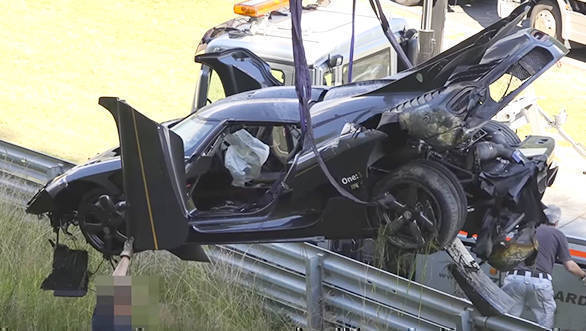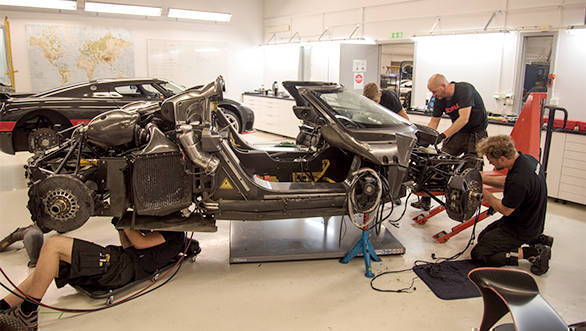ABS failure causes Koenigsegg One:1 crash at Nurburgring
Four days ago, an extremely rare Koenigsegg One:1 suffered a heavy crash at the Nurburgring. Hypercar crashes that pop up on the internet are usually by owners whose financial power outshines their driving skill. This crash however, was at the hands of a factory driver on an official test. It's no secret that Koenigsegg is gunning for the Nurburgring lap record with the One:1 and this particular car was running test sessions towards the record attempt. Long skid marks on the track leading up to the crash indicated at wheel lock up, which would mean that the driver wasn't at fault as the One:1 has ABS. Koenigsegg has now revealed in a detailed post on their website what exactly happened.
After shipping the wreckage back to headquarters, Koenigsegg was able to to go through all the data from the on-board telemetry system. As it turns out, the car suffered an ABS sensor failure (a generally low cost component that is purchased from external vendors) in the left front wheel. Data analysis shows that the alert was displayed on the instrument cluster quite a few corners before the crash. However, the driver was concentrating on keeping the 1360PS/1360kg (hence the name) rear wheel drive monster under control. It's easy to understand how he never saw the warning.
Upto the point of the crash, the driver never had to brake hard enough to approach the limits of adhesion and trigger ABS. Koenigsegg says pedal feel will not generally change and there are no tell tale signs of ABS not working till the wheel locks up. From my experience, and also chatting with Armaan Ebrahim, cars that are designed to work with ABS won't provide optimal braking performance if the system is disabled. The driver never saw it coming.
At the Fuchsröhre section of the track which demands heavy braking, the driver got on the brakes hard at about 170kmph. The front axle locked up and the car went off the track. The car rammed into the Armco barrier at a massive 110kmph and flew for about 22m before landing on its rear left wheel. Incredibly, the driver not only got out safely, but also managed to use the car's fire extinguisher to put out a small fire that resulted as the carbon fibre panels came in contact with the hot exhaust.

A ray of sunshine for Koenigsegg in this gloomy incident is that the car's crash structure worked incredibly well. Exterior panels and subframes were badly damaged, but the carbon fibre monocoque that forms the chassis was intact. The roof held shape and both swivel doors opened allowing the driver to safely exit the vehicle. Later examination showed that the fuel shut-off system worked perfectly and there were no oil or hydraulic fuel leaks either It's great to see that despite the primary focus of performance through weight loss, a hypercar like the Koenigsegg can also offer impeccable safety. For relation, the Global NCAP tests that so many Indian built cars seem to be failing have an impact speed of 60kmph, nearly half of what this One:1 endured. Of course, $1.5 million One:1 costs a hundred times more than the average Indian car so there's no comparison there! But it's nice to see that performance does not come at the sacrifice of safety and that the One:1 can withstand far more than the law mandates.
 The Koenigsegg team inspected the car and found that its crash structure worked perfectly
The Koenigsegg team inspected the car and found that its crash structure worked perfectly
Part of the reason why the crash wasn't worse, is that the One:1 has a back-up feature that is found in many cars with ABS systems. When an ABS malfunction is detected with the front wheels, the rear wheels are allowed to rotate and will not lock up. If they were to lock, the car could go into an uncontrollable spin. Modern Koenigseggs also have what the company calls an Active Safety Warning system. What this does is constantly monitor all active systems including, the front aero flaps underneath the bumper, active ride height system, active rear wing and the active rebound dampening system. If a fault in any is detected, the car automatically goes into a limp mode with a top speed of 100kmph, allowing it to be taken to a workshop for repair. After this incident, Koenigsegg will include ABS under the Active Safety Warning umbrella.

The good news continues. Since the carbon monocoque survived the impact, Koenigsegg will rebuild this One:1 and the car will return to the 'ring to attempt the record. The company is unable to suggest whether the car will be ready by the end of this year but isn't ruling it out. Till then, head over to the Koenigsegg website to read the full report.














